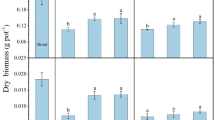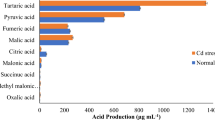Abstract
Plant associated-bacteria can facilitate the host plant in overcoming contaminant-induced stress responses as well as improve plant development and growth. In this study, a successful approach was reported to reduce the Dibutyl phthalate (DBP) levels of polluted soil and, consequently, to improve cucumber growth. DBP suppressed development of cucumber seedings significantly, damage sub-cellular of root, especially the biomembrane system, and affected the microbial community structures of the soil. When DBP was applied at a concentration of 5 mg/kg to cucumber seedlings inoculated with degrading strain DNB-S1, the DBP residue in roots was very low. When the cucumber plants were exposed to DBP stress over 20 and 40 mg/kg DBP, the DBP residues in the roots inoculated with degrading strain DNB-S1 were reduced by 36.5% and 40.42% respectively, compared with the non-inoculation group. Moreover, DBP dissipation in rhizosphere soil is accelerated through inoculation with DNB-S1 which could effectively relieve the pressure of DBP stress on plant. The dry weight of cucumber roots inoculated with DBP-degrading bacterium was higher than that of non-inoculated seedlings. According to ultrastructural micrographs, the DBP-degrading bacteria could considerably alleviate the damaging effect of DBP on cucumber root cell organs. The application of strain DNB-S1 could efficiently alleviated the stress of DBP on the microbial community structure.






Similar content being viewed by others
References
Afzal M, Yousaf S, Reichenauer TG, Sessitsch A (2012) The inoculation method affetcs colonization and performance of bacterial inoculant strains in the phytoremediation of soil contaminated with diesel oil. Int J Phytoremediation 14(1):35–47
Al-Saleh I, Elkhatib R, Al-Rajoudi T, Al-Qudaihi G (2017) Assessing the concentration of phthalate esters (PAEs) and bisphenol A (BPA) and the genotoxic potential of treated wastewater (final effluent) in Saudi Arabia. Sci Total Environ 578:440–451
Balseiro-Romero M, Gkorezis P, Kidd PS, Vangronsveld J, Monterroso C (2016) Enhanced degradation of diesel in the rhizosphere of after inoculation with diesel-degrading and plant growth-promoting bacterial strains. J Environ Qual 45(3):924–932
Chao WL, Cheng CY (2007) Effect of introduced phthalate-degrading bacteria on the diversity of indigenous bacterial communities during di-(2-ethylhexyl) phthalate (DEHP) degradation in a soil microcosm. Chemosphere 67(3):482–488
Du PP, Huang YH, Huixiong Lü et al. (2020) Rice root exudates enhance desorption and bioavailability of phthalic acid esters (PAEs) in soil associating with cultivar variation in PAE accumulation. Environ Res 186:109611
Deng Y, Zhang Y, Gao Y, Li D, Liu R, Liu M, Zhang H, Hu B, Yu T, Yang M (2012) Microbial community compositional analysis for series reactors treating high level antibiotic wastewater. Environ Sci Technol 46(2):795–801
Eleftheriou AEP, Karataglis S (2015) Ultrastructural and morphological characteristics of cultivated wheat growing on copper‐polluted fields. Plant Biol 102(2):134–140
Feng NX, Yu J, Mo CH, Zhao HM, Li YW, Wu BX, Cai QY, Li H, Zhou DM, Wong MH (2018) Biodegradation of di-n-butyl phthalate (DBP) by a novel endophytic Bacillus megaterium strain YJB3. Sci Total Environ 616–617:117–127
Franco A, Prevedouros K, Alli R, Cousins I (2007) T Comparison and analysis of different approaches for estimating the human exposure to phthalate esters. Environ Int 33(3):283–291
Gadhave KR, Devlin PF, Ebertz A, Ross A, Gange AC (2018) Soil Inoculation with Bacillus spp. modifies root endophytic bacterial diversity, evenness, and community composition in a context-specific manner. Microb Ecol. https://doi.org/10.1007/s00248-018-1160-x
Gao DW, Wen ZD (2016) Phthalate esters in the environment: a critical review of their occurrence, biodegradation, and removal during wastewater treatment processes. Chemosphere 191:36–43
Hamdi H, Benzarti S, Manusadzˇianas L, Aoyama I, Jedidi N (2007) Solid-phase bioassays and soil microbial activities to evaluate PAH-spiked soil ecotoxicity after a long-term bioremediation process simulating landfarming. Chemosphere 70(1):135–143
Kapanen A, Stephen JR, Bruggemann J, Kiviranta A, White DC, Itavaara M (2007) Diethyl phthalate in compost: ecotoxicological effects and response of the microbial community. Chemosphere 67(11):2201–2209
Khan MM, Islam E, Irem S, Akhtar K, Ashraf MY, Iqbal J, Liu D (2018) Pb-induced phytotoxicity in para grass (Brachiaria mutica) and Castorbean (Ricinus communis L.): antioxidant and ultrastructural studies. Chemosphere 200:257–265
Komatsu S, Kuji R, Nanjo Y, Hiraga S, Furukawa K (2012) Comprehensive analysis of endoplasmic reticulum-enriched fraction in root tips of soybean under flooding stress using proteomics techniques. J Proteomics 77(24):531–560
Kong S, Ji Y, Liu L, Chen L, Zhao X, Wang J, Sun Z (2013) Spatial and temporal variation of phthalic acid esters (PAEs) in atmospheric PM 10 and PM 2.5 and the influence of ambient temperature in Tianjin, China. Atmos Environ 74:199–208
Kuppusamy S, Thavamani P, Megharaj M, Venkateswarlu K, Lee YB, Naidu R (2016) Pyrosequencing analysis of bacterial diversity in soils contaminated long-term with PAHs and heavy metals: Implications to bioremediation. J Hazard Mater 317:169–179
Li R, Liang J, Gong Z, Zhang N, Duan H (2017) Occurrence, spatial distribution, historical trend and ecological risk of phthalate esters in the Jiulong River, Southeast China. Sci Total Environ 580:388–397
Li WC, Wong MH (2012) Interaction of Cd/Zn hyperaccumulating plant (Sedum alfredii) and rhizosphere bacteria on metal uptake and removal of phenanthrene. J Hazard Mater 209-210(4):421–433
Li Y, Zhou C, Huang M, Luo J, Hou X, Wu P, Ma X (2016) Lead tolerance mechanism in Conyza canadensis: subcellular distribution, ultrastructure, antioxidative defense system, and phytochelatins. J Plant Res 129(2):251–262
Lu H, Mo CH, Zhao HM, Xiang L, Katsoyiannis A, Li YW, Cai QY, Wang MH (2018) Soil contamination and sources of phthalates and its health risk in china: a review. Environ Res 164(JUL.):417–429
Marzorati M, Wittebolle L, Boon N, Daffonchio D, Verstraete W (2008) How to get more out of molecular fingerprints: practical tools for microbial ecology. Environ Microbiol 10(6):1571–1581
Miodovnik A, Edwards A, Bellinger DC, Hauser R (2014) Developmental neurotoxicity of ortho-phthalate diesters: review of human and experimental evidence. Neurotoxicology 41:112–122
Pacwa-Plociniczak M, Pzaza GA, Piotrowska-Seget Z, Cameotra SS (2011) Environmental applications of biosurfactants: recent advances. Int J Mol Sci 12(1):633–654
Roling WFM, Milner MG, Jones DM, Lee K, Daniel F, Swannell RJP, Head IM (2002) Robust hydrocarbon degradation and dynamics of bacterial communities during nutrient-enhanced oil spill bioremediation. Appl Environ Microbiol 68(2002):5537–5548
Soltys D, Rudzińska-Langwald A, Kurek W, Szajko K, Sliwinska E, Bogatek R, Gniazdowska A (2014) Phytotoxic cyanamide affects maize (Zea mays) root growth and root tip function: from structure to gene expression. J Plant Physiol 171(8):565–575
Sun J, Wu X, Gan J (2015) Uptake and metabolism of phthalate esters by edible plants. Environ Sci Technol 49:8471–8478
Vergani L, Mapelli F, Zanardini E, Terzaghi E, Di Guardo A, Morosini C, Raspa G, Borin S (2017) Phyto-rhizoremediation of polychlorinated biphenyl contaminated soils: an outlook on plant-microbe beneficial interactions. Sci Total Environ 575:1395–1406
Wang GH, Jin J, Xu MN, Pan XW, Tang C (2007) Inoculation with phosphate-solubilizing fungi diversifies the bacterial community in rhizospheres of maize and soybean. Pedosphere 17(2):191–199
Wang Y, Zhang G, Wang L (2015) Potential toxicity of phthalic acid esters plasticizer: interaction of dimethyl phthalate with trypsin in vitro. J Agric Food Chem 63(1):75–84
Waters LJ, Leharne SA, Mitchell JC, Hanrahan JP (2007) Determination of micelle/water partition coefficients and associated thermodynamic data for dialkyl phthalate esters. J Therm Anal Calorim 90(1):283–288
White JC, Ross DW, Gent MPN, Eitzer BD, Mattina MI (2006) Effect of mycorrhizal fungi on the phytoextraction of weathered p, p-DDE by Cucurbita pepo. J Hazard Mater 137(3):1750–1757
Xu G, Li FS, Wang QH (2008) Occurrence and degradation characteristics of dibutyl phthalate (and di-(2-ethylhexyl) phthalate (DEHP) in typical agricultural soils of China. Sci Total Environ 393(393):333–340
Xu XR, Li HB, Gu JD (2007) Metabolism and biochemical pathway of n-butyl benzyl phthalate by Pseudomonas fluorescens B-1 isolated from a mangrove sediment. Ecotoxicol Environ Saf 68:379–385
Zhang Y, Tao Y, Sun GQ, Wang L (2014b) Effects of di-n-butyl phthalate on the physiology and ultrastructure of cucumber seedling roots. Environ Sci Pollut R 21(10):6662–6670
Zhang Y, Tao Y, Zhang H, Wang L, Sun GQ, Sun X, Li M (2015) Effect of di-n-butyl phthalate on root physiology and rhizosphere microbial community of cucumber seedlings. J Hazard Mater 289:9–17
Zhang Y, Wang L, Du N, Ma GP, Yang AM, Zhang H, Wang ZG, Song QX (2014a) Effects of diethylphthalate and di-(2-ethyl)hexylphthalate on the physiology and ultrastructure of cucumber seedlings. Environ Sci Pollut R 21(2):1020–1028
Złoch M, Thiem D, Gadzała-Kopciuch R, Hrynkiewicz K (2016) Synthesis of siderophores by plant-associated metallotolerant bacteria under exposure to Cd(2.). Chemosphere 156:312–325
Acknowledgements
This work was supported by the National Natural Science Fund for Distinguished Young Scholars (41625002), the MOA Modern Agricultural Talents Support Project, the Second Batch of National “10,000 Person Plan” in 2016, the National Natural Science Foundation of China (41877128), the National Natural Science Foundation of China (31972941), the National Natural Science Foundation of China (31901189), the National Natural Science Foundation of China (41961144030), the major projects of research and development program of application technology of Heilongjiang Province of China (GA19B105), Heilongjiang Provincial Key Laboratory of Soil Protection and Remediation.
Author information
Authors and Affiliations
Corresponding author
Ethics declarations
Conflict of interest
The authors declare that they have no conflict of interest.
Additional information
Publisher’s note Springer Nature remains neutral with regard to jurisdictional claims in published maps and institutional affiliations.
Rights and permissions
About this article
Cite this article
Li, S., Wang, L., Li, Y. et al. Biodegradation of Di-n-butyl phthalate in rhizosphere and growth-promoting effect of Cucumis sativus Linn. by a novel Pseudomonas sp. DNB-S1. Ecotoxicology 30, 1454–1464 (2021). https://doi.org/10.1007/s10646-020-02287-0
Accepted:
Published:
Issue Date:
DOI: https://doi.org/10.1007/s10646-020-02287-0




